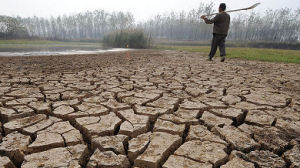Ten ideas to save the planet: geoengineering
Could cloud whitening and sucking carbon dioxide out of the atmosphere balance the effects of climate change? Our scientists give us their geoengineering ideas.

What idea policy or technology holds the greatest promise for tackling climate change? That was the question Channel 4 News posed to the scientific community over the past few weeks.
Thanks to the extensive contacts of the Science Media Centre at the Royal Institution Channel 4 News was able to email hundreds of scientists across various fields of expertise to sound-out their opinions.
There is a chance that we may not be able to lower our emissions enough to reverse the effects of climate change so engineering could be crucial.
A number of the scientists who contacted Channel 4 News felt that it was time to start thinking seriously about ideas such as sucking the carbon out of the skies or painting clouds white.
“I increasingly feel that the world won’t act fast enough,” said Brian Launder from the University of Manchester.
“Neither governments nor their electorates have properly acknowledged that CO2 released today only gets reabsorbed on a 100-year timescale.
Climate change: 10 ideas to save the planet
“So even with a really major year-on-year reduction (of say 8 per cent per year for 20 years – which is unlikely) the problem is still going to keep on getting worse.”
Various techniques were suggested as ways of deliberately manipulating the Earth’s atmosphere in order to reduce the build-up of green house gasses – or, as more commonly know, geoengineering.
Recently the Royal Society published a report on the future of geoengineering and whether it held the key to climate change.
They divided technologies into two categories:
Carbon dioxide removal
Sucking emissions out of the atmosphere address the root cause of climate change, according to the Royal Society.
So far engineering ideas have ranged from artificial trees that draw emissions out of the atmosphere to developing marine algae which soaks up carbon dioxide. Other natural processes such as biochar can be found here: the growing problem.
The problem with carbon dioxide removal is that methods work slowly to reduce global temperatures.
Solar engineering management
Among the scientists who contacted Channel 4 News about geoengineering most were interested in ways of shielding the plant from the sun’s rays.
Solar radiation management is designed to reflect a small amount of the sun’s light and heat back into space thus cooling parts of the Earth.
Alan Gadian is currently developing a technique called cloud whitening at the National Centre for Atmospheric Science.
The idea, originally conceived by Professor John Latham, sprays microscopic seawater droplets into the atmosphere.
It is thought this could increase the reflectivity of the Earth with the clouds reflecting sunlight back into space. The droplets would be propelled into the air from using solar of wind powered vessels and would be totally green.
Brian Launder from the University of Manchester agreed that along with “stratospheric aerosols” cloud whitening should be pursued and “rapidly implemented”.

Professor Peter Styring from the University of Sheffield contacted Channel 4 News about a project he is working on with the Engineering and Physical Research Sciences Council.
Prof Styring said it would “not only capture CO2 from the atmosphere but convert it back into useful commodity chemicals and fuels.
“Therefore, CO2 will become a prized asset rather than a problematic waste. The US has started down this road but there is sufficient expertise in the UK to become world leaders.
“As fossil fuels deplete, this will produce an alternative supply of feed stocks outside the petrochemicals arena.”
Professor Bruce Hamilton from the University Of Manchester suggested another technique for shielding the Earth from the Sun.
“One technology approach which is risky might be to perform atmospheric engineering,” he said. “I expect that we shall have to turn to solar radiation management for several decades until large-scale solar-based energy schemes (along with the associated infrastructure) have come to maturity.
“This would involve placing some kind of reflective elements in upper atmosphere to do the job that clods do lower down.
“This would require lots of modelling and lots of engineering challenges but may be doable. It may also be a reversible solution.”

The quick fix problem
Although Dr Andrew Yool from Southampton University said that stratospheric aerosols may allow temperatures to decrease, he pointed out the problems behind geoengineering.
“Since this particular technology does nothing to address the root cause of climate change, it categorically should not be viewed as anything other than a temporary “fix”,” he said.
“Furthermore… all geoengineering technologies have significant negative aspects (e.g. deleterious side-effects, prohibitive cost), and none should be viewed as preferable options.”
The Royal Society’s geoengineering report recommended that significant development was needed if these techniques were to be beneficial for the environment.
All geoengineering technologies have significant negative aspects and none should be viewed as preferable options.” Dr Andrew Yool
They called for a £100m annual global research fund to study geoengineering technologies and said that the British government should contribute £10m a year – ten times the amount being spent now on such research.
The report also warned that creating artificial clouds could disrupt rain patterns resulting in catastrophic consequences such as mass starvation.
The Royal Society concluded that, as with many of the ideas that were proposed to Channel 4 News, geogengineering should only be used as a part of wider methods to mitigate climate change.